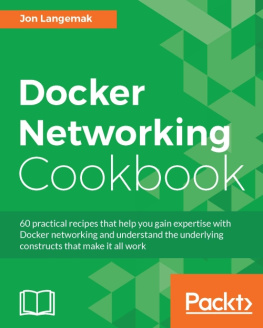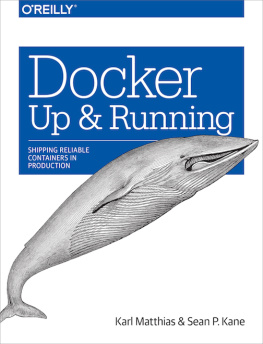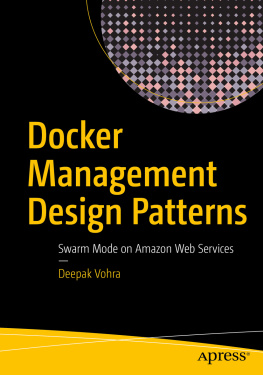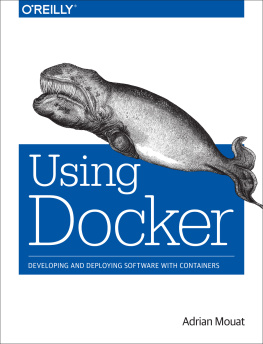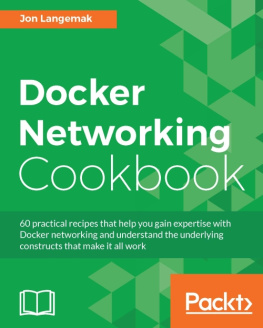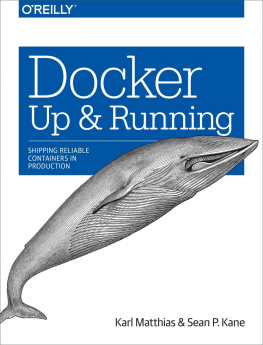Docker Networking Cookbook
Copyright 2016 Packt Publishing
All rights reserved. No part of this book may be reproduced, stored in a retrieval system, or transmitted in any form or by any means, without the prior written permission of the publisher, except in the case of brief quotations embedded in critical articles or reviews.
Every effort has been made in the preparation of this book to ensure the accuracy of the information presented. However, the information contained in this book is sold without warranty, either express or implied. Neither the author, nor Packt Publishing, and its dealers and distributors will be held liable for any damages caused or alleged to be caused directly or indirectly by this book.
Packt Publishing has endeavored to provide trademark information about all of the companies and products mentioned in this book by the appropriate use of capitals. However, Packt Publishing cannot guarantee the accuracy of this information.
First published: November 2016
Production reference: 1231116
Published by Packt Publishing Ltd.
Livery Place
35 Livery Street
Birmingham B3 2PB, UK.
ISBN 978-1-78646-114-8
www.packtpub.com
Credits
Author
Jon Langemak
Reviewer
Francisco Souza
Commissioning Editor
Priya Singh
Acquisition Editor
Rahul Nair
Content Development Editor
Rashmi Suvarna
Technical Editor
Mohd Riyan Khan
Copy Editor
Dipti Mankame
Project Coordinator
Judie Jose
Proofreader
Safis Editing
Indexer
Pratik Shirodkar
Graphics
Kirk D'Penha
Production Coordinator
Deepika Naik
Cover Work
Deepika Naik
About the Author
Jon Langemak has over 10 years of experience in designing, building, and maintaining high-performance networks. He is passionate about network operations, automation, and open source tooling. His current focus is on disruptive technologies and the impact they have on network operations. Outside of work, Jon blogs at dasblinkenlichten.com and enjoys collaborating with others in the network community on new ideas and concepts.
I would like to thank my wife for her encouragement and for tolerating the countless days of late night writing. I would also like to thank all of the amazing people in the networking community I've had the privilege to meet over the past few years. I consider myself lucky to call many of you friends and appreciate all the support and inspiration you continue to provide me. And finally, I'd like to thank my parents, who piqued my interest in computing by giving me my first computer in elementary school. Thank you for supporting my interests and ambitions; you have always been there for me.
About the Reviewer
Francisco Souza is a senior software engineer working with video publishing platforms at The New York Times. Prior to that, he worked with the open source PaaS Tsuru, created back in 2012 and later adapted to leverage Docker for container management. Francisco is also a Docker Captain, and he likes to explore topics such as concurrency, parallelism, and distributed systems.
He has also worked as a reviewer in the book Extending Docker , Russ McKendrick , Packt publishing .
www.PacktPub.com
eBooks, discount offers, and more
Did you know that Packt offers eBook versions of every book published, with PDF and ePub files available? You can upgrade to the eBook version at > for more details.
At www.PacktPub.com, you can also read a collection of free technical articles, sign up for a range of free newsletters and receive exclusive discounts and offers on Packt books and eBooks.
https://www.packtpub.com/mapt
Get the most in-demand software skills with Mapt. Mapt gives you full access to all Packt books and video courses, as well as industry-leading tools to help you plan your personal development and advance your career.
Why Subscribe?
- Fully searchable across every book published by Packt
- Copy and paste, print, and bookmark content
- On demand and accessible via a web browser
Preface
The aim of this book is to provide you with in-depth knowledge of how Docker implements container networking. Whether you use Docker every day or are just getting started, this book will introduce you to how Docker uses Linux networking primitives to network containers. Through numerous examples, well cover everything from the fundamentals of Linux networking to the latest Docker networking drivers. Along the way, well also look at integrating existing networking constructs and third-party plugins into Docker. The end goal is for you to be comfortable with the process Docker uses to provide networking capabilities to containers.
Like many open source projects, Docker is a fast-moving piece of software. At the time of publication, the most recent version of Docker was 1.12. Ive done my best to ensure that the content in this book reflects the most up-to-date features and configurations based on this version. Regardless of the version, many of these features have existed in one form or another since the very early versions of Docker. So while there have been significant changes in Docker networking over the last couple of years, much of the network functionality is still implemented in the same manner. It is for this reason that I believe the majority of the content in this book will remain relevant for a long time to come.
What this book covers
, Linux Networking Constructs , will focus on introducing you to Linux networking primitives. Topics such as interface creation, addressing, and general connectivity will be discussed in detail. You will also be introduced to common Linux command-line syntax and tooling as it relates to Linux host network configuration. Understanding these basic constructs will greatly increase your ability to understand how Docker handles container networking.
, Configuring and Monitoring Docker Networks , explains the default means in which Docker handles container networking. These include bridge, host, and mapped container modes of Docker network operation. Well also begin our exploration of how Docker handles mapping container-based services to the outside or external network. There will also be discussion around Linux host requirements for Docker networking and some of the possible Docker service-level parameters that can be modified.
, User-Defined Networks , begins our discussion on Docker user-defined networks. The advent of user-defined networks has greatly increased the flexibility of Docker networking providing the end user far more possibilities in regard to container connectivity. Well discuss the syntax required to create user-defined networks as well as show examples of how to create user-defined bridge and overlay-based networks. Finally, well cover some options to isolate network segments within Docker.
, Building Docker Networks , begins with a deep dive into how Docker provides container connectivity. Starting with a container that was provisioned without a network interface, well cover all the steps required in order to get the container communicating on the network. Well then move on to discuss other options to use custom bridges with Docker and cover multiple use cases related to using OVS in conjunction with Docker.

